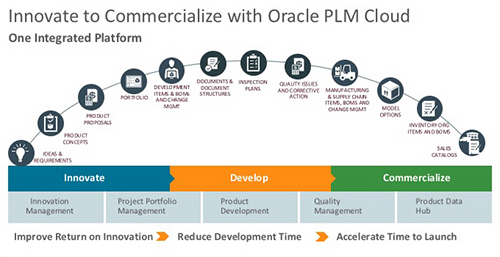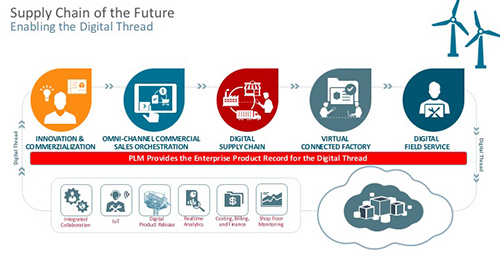
CIMdata's Vice President of Research, Stan Przybylinski, recently sat down with Oracle's Vice President PLM Products, John Kelley, so that he could learn more about Oracles's cloud strategy.
Let's find out!
Let’s talk about Oracle’s strategic commitment to the cloud.
Oracle’s cloud strategy is the development of net new 100 percent cloud-based applications across our entire portfolio, including Oracle Enterprise Resource Planning (ERP) Cloud, Customer Experience (CX) Cloud, Human Capital Management (HCM) Cloud, Supply Chain Management (SCM) Cloud, and Product Lifecycle Management (PLM) Cloud. The figure below highlights Oracle PLM Cloud. Oracle PLM Cloud spans the entire product lifecycle from Innovation through to Commercialization (I2C).

We manage a product’s evolution from a raw idea through to a fully commercialized product that is ready for customers to order and for manufacturing and supply chain to build and ship the product. Because Oracle PLM Cloud extends to product commercialization tasks, this eliminates the gap where companies “throw it over the wall” to ERP and hope it’s done right. Oracle PLM Cloud extends upstream into ideation and downstream into commercialization to accelerate not just New Product Development (NPD), but also New Product Introduction (NPI). These new cloud-based applications are targeted to the public cloud, using Oracle’s approach to multi-tenant, where it is done at the database level. In fact, Oracle can offer the whole stack. We develop our own hardware and storage, and operate our own data centers around the world.
In addition to Oracle’s cloud suite, Oracle also supports all on-premise applications including Agile PLM on Oracle Infrastructure as a Service (IaaS), in a hosted or managed cloud offering. This provides our customers a flexible path to the cloud, either a transition from on-premise to managed cloud or a transformation to a full PLM cloud with Oracle PLM Cloud.
What about the ecosystem of infrastructure, applications, and other partners that are part of your offerings?
Partners and Oracle Consulting Services are adding their own value by building “quick start” packages to get rapid time to value in the cloud, as well as developing new cloud extensions and applications on Oracle Platform as a Service (PaaS).
The cloud is a reality today. Everyone is evaluating a move or already moving to the cloud. Looking at our customer base, we no longer have conversations with CIOs where cloud is not discussed. From a customer point of view, this is a massive shift. All of the customers we talk to are considering a path to the cloud, whether it is a complete transformative move or a hybrid approach. But everyone is asking, trying to understand, and listening. Oracle has been working on its cloud strategy for over a decade, and in particular the PLM Cloud products for the last five years. Some thought when Oracle started our PLM transition to the cloud that it was too early. But starting then gave us time to redevelop our applications while the market was transitioning. Now we have viable products and the market is ready too.
How does your solution and its go-to-market address the issues raised by your customers and prospects?
One of Oracle’s core business philosophies is our Applications Unlimited pledge. Oracle has promised the customers of our many software acquisitions that we would continue to support their on-premise solutions, and we have. Oracle Agile PLM is a best-of-breed point solution, tightly integrating into the Oracle E-Business Suite (EBS) and SAP ERP. You can deploy Agile PLM solutions on-premise or in Oracle IaaS.
In parallel, Oracle has also developed an end-to-end supply chain management (SCM) solution in the cloud, which includes PLM. Since Oracle SCM Cloud and Oracle PLM Cloud are built on the same cloud platform and share the same database tables, it is seamlessly integrated out of the box. Complex connectors are no longer needed to transfer data from one application to another. In the Oracle Cloud, promoting a development item in PLM to make it visible for SCM operations is as simple as changing the lifecycle attribute of an item from “design” to “production.” Being on one platform allows us to create a common digital thread and enable seamless cross-solution use cases.
If customers want to integrate Oracle PLM Cloud with solutions from other providers, we offer the Oracle Integration Cloud service. Different solutions offer REST services that are registered, and it enables users to build connectors graphically.
Customers also have to be more integrated in their thinking, going beyond just PLM as an engineering database. This is where Oracle offers a real advantage. With more products integrating hardware and software, and the advent of the Internet of Things (IoT), companies will be looking for solutions that span ideation, engineering, manufacturing, and in-service use to support their development and lifespan, as shown in the figure below.

Can you provide any Information on your installed base to date?
While Oracle doesn’t disclose individual numbers, I can tell you that the cloud discussion is front and center in every customer meeting. After our annual Modern Supply Chain Experience (MSCE) conference, we conduct a post-event survey that asks attendees to rate their cloud readiness. In 2016, 33 percent responded that they were ready; in 2017 that number grew to over 50 percent. We are having vastly different conversations with customers and prospects regarding cloud-based solutions. Now the questions we get from customers suggest that people are embracing the technology and are trying to learn how best to get there.
How are your offerings going to evolve in the short to medium term (1-3 years)?
We plan to continue rounding out the PLM Cloud core capabilities, but in addition, we are putting a lot of energy into the cross-functional use cases we discussed earlier, like new product introduction workflows that extend beyond traditional PLM boundaries to help customers – much faster and more accurately - ready a product for omni-channel commerce and supply chain execution. These extended tasks are what we call product commercialization. We think the types of use cases that tie PLM to SCM, MFG, and CX will help our customers maximize their investment in our cloud-based offerings. Beyond that, Oracle is committed to leadership in the PLM market segment. As always, we plan to continue to work in close partnership with our customers and industry experts to evolve and innovate our PLM applications as part of our mission to offer the industry’s most competitive solution. I encourage anyone who is interested in learning more about the Oracle PLM Cloud to visit cloud.oracle.com/plm.
We look forward to hearing your comments.
Stan




